WITHIN the list of ‘neglects’ that the Amerindians of Guyana had to endure, during the years of the People’s National Congress (PNC) regime, was access to quality education.

And this was so, despite the establishment of the Amerindian Scholarship Fund in 1962, which was not properly supported by adequate funding. This meant that there was no efficaciousness in catering for the educational tuition of the many Amerindians eligible for this accommodation. What this translated to was that Amerindians were continuously at a disadvantaged position as far as obtaining quality education, thus rendering them incapable of competing for desirable employment opportunities.
This hopeless scenario, however, was predestined to change, and in retrospect, it is evident that a drastic one did take place. The reason inheres in the reality of huge investments and innovative interventions that were meted out over years, since the People’s Progressive

Party/Civic (PPP/C) administration took office in 1992, as it embarked on an Education Strategic Plan, which saw the implementation of many programmes and policies, and the rehabilitation of schools and the construction of new ones where none had previously existed.
Hinterland Scholarship Programme
The Hinterland Scholarship Programme (HSP) that affords academic opportunities, at both the secondary and tertiary levels, took centre stage of this great revitalisation of Amerindian education.
In 1963, six scholarships were offered under this programme. However, since 1992, the programme has undergone an expansion that is allowing it to be more comprehensive.
This programme, which allows for the integration of hinterland students into the wider Guyanese society, and which provides them with quality secondary and technical education not accessible in their communities, offers two types of scholarships: the regional and national scholarship. The programme is supported by the Government, through the Ministry of Amerindian Affairs, and provides students with a monthly stipend, school necessities, accommodation and meals.

For the regional aspect, students are required to obtain 470 marks at the National Grade Six Examination, while for the national level, students are required to obtain more than 480 marks to be awarded schools in Georgetown and its environs.
It has thus far benefitted more than 1000 students, and has produced nurses, midwives, medex, engineers, teachers, and agriculturalists, who, after their initial training, returned to their respective communities to share their development skills. There are also Amerindians in Cuba, on scholarships, ranging from medicine to agronomy and Information Technology. In 2014, $66.6 million was allocated from the National Budget to the Hinterland Scholarship Programme.

Infrastructure
Prior to 1993, there was hardly any proper educational infrastructure in Amerindian communities, and students had to travel long distances, either by foot or canoe, in order to attend school. As a result of this discomfort, many children did not attend school regularly, and it led to a huge number of drop-outs and absenteeism.
However, recognising this injustice, the PPP/C administration began building schools wherever feasible, to ensure that children attend schools close to their communities.
Today, there are over 250 schools, spread across the regions, 116 nursery, 139 primary, and 12 secondary schools, thus adequately catering for a wide spread of students.

Secondary education
At the secondary level, the administration ensured several institutions were constructed in the hinterland areas. Up to year 2003, less than 13% of the households in the rural interior had access to secondary education.
From one secondary school that existed in Region 2 decades ago, scondary schools now exist in communities such as, Mabaruma, Port Kaituma and Santa Rosa, Region 1; St Cuthbert’s Mission, Region 4; Waramadong, Jawalla and Three Miles, Region 7; Mahdia and Paramakatoi, Region 8; and Annai, Aishalton, St. Ignatius, and Sand Creek, Region 9.
Moreover, works are ongoing on the construction of the state-of-the-art $780M secondary school at Kato, Region 8. This school is expected to house 1000 students and is schedule to be completed this year.
Primary schools
Guyana has achieved Universal Primary Education, which means that every child, regardless of his location, now has access to a primary school.
To this end, a number of primary facilities were constructed in many hinterland communities, with the most recent being the Lower Kaituma Primary and Mabaruma Primary, Region 1; Bethany Primary, Region 2; Mora Point Nursery and Karamat Primary, Region 5; Quebanang Primary and Nursery, Region 7; Paramakatoi Primary, Region 8; Arapaima Primary, Baitoon Primary, Semonie Primary, and Rockstone Primary, Region 10.
Accommodation
In order to accommodate students who attend school far away from their communities, a number of dorm facilities have been constructed and renovated in Regions 1, 2, 7, 8 and 9. The $95.4 dormitory facility at Liliendaal facilitates students who are studying on the coast.
Trained teachers
Recognising the large number of untrained and unqualified teachers in the Hinterland schools, Government quickly embarked on a number of initiatives to facilitate distance training for teachers, one being the Guyana Basic Education Teacher Training Programme.
Thus far, over 1200 teachers and 400 principals in Regions 1, 7, 8, and 9 have benefited from this important intervention.
Of note also is an amazing reality: 90 percent of the schools also now have teachers’ houses; 90% are equipped with sanitary blocks; 45% with electricity; and 83% with water facilities.
Social assistance programmes
Government embarked on a number of initiatives, in order to improve students’ attendance, as this is basic where education is concerned, so the efforts were directed at providing them with a better opportunity to complete school, thus receiving a sound and full education. There are now the school uniform and school feeding programmes; more recently, an education grant was added.
The National School Feeding and Uniform programmes are aiding thousands of hinterland students, providing them with hot meals, and uniforms. These have positively impacted students’ attendance and performance.
Further, the Government’s “Because We Care” $10,000 cash grant programme was a timely addition; it was launched in 2014, and saw each student in the public school system, benefiting from it.
Hinterland Education Improvement Programme
While Government has been able to put in place the necessary infrastructure, it was concerned about the quality of education that was being delivered, and hence the implementation of the Hinterland Education Improvement Programme (HEIP).
This programme targets specific areas that need Government’s intervention, and is to be implemented in Regions 1, 7, 8 and 9. It is a five-year plan to improve education delivery in the hinterland and riverine areas. Among the targeted components are: improvement of quality of teacher education; aligning teaching-learning resources to improve students’ outcome; improving physical facilities; fostering community alliances; and strengthening management supervision.
Education Channel
The Education Channel is another initiative which allows for students to have access to numerous educational programmes in areas such as mathematics, chemistry, the English Language, physics, biology, social studies, debates, spelling, examination tips, preparing School Based Assessments (SBA), sign language, foreign language, cultural documentaries and Guyanese history.
This channel has about 200,000 viewers and is being received in remote areas such as Mahdia, Region 8; Aishalton, Annai, and Lethem, Region 9; and Port Kaituma, Region 1; and more recently, Moraikobai, a riveine community in Region 5.
Source: http://guyanachronicle.com/2015/01/19/amerindians-and-national-education-initiatives




